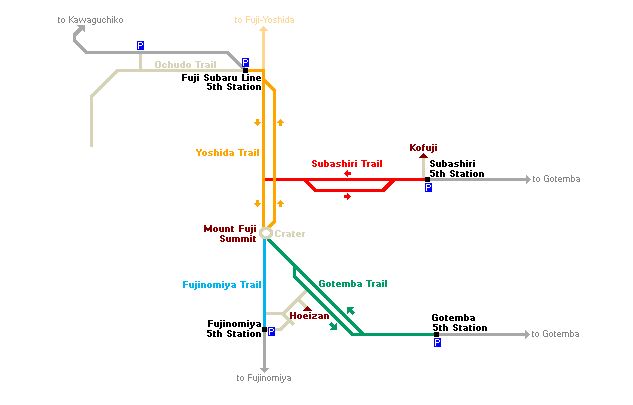One of our favorite views of Mount Fuji from the tea plantations of Fuji City!
-Randy Lynch
Japan’s highest and most notable mountain (12,388 ft/3,776 meters), climbing Mt. Fiji is a cultural right of passage for many Japanese, as well as for many across the world. With a very short climbing season, (July 01 – August 31), up to 250,000 climbers make the trek each year, with more than 5,000 per day on weekends and during OBON week in mid-August. OBON week is an annual Japanese tradition where one honors the spirits of their ancestors. Though the weather tends to be more unpredictable in early July, you will encounter fewer crowds during this time as it is just before the start of school summer vacations. In contrast to our various hikes in New Zealand, Iceland, Switzerland, Norway and South America, we would not describe the hike up Mt. Fuji as picturesque or idyllic. Long walks are good for conversations and work as a great digestif. The best way to get the most out of your change of scenery, is by leaving the tracking gadgets behind and sharing a friendly greeting with fellow hikers along the way. We feel this is more of a less intense adventure/cultural experience as you bond with your fellow climbers in sharing a life-long memory!

Sign At the Start of a Mt. Fuji Trail
Our Favorite Trail
We suggest the popular and most accessible (Fuji Subaru Line; yellow) 1.5-mile Yoshida Trail up to Mt. Fuji. The ascent time is approximately 5-7 hours, while the descent averages 3-5 hours. There are many rest/sleeping huts along the trail near the 7th and 8th stations if you prefer to ascend at a more relaxed pace to take it all in. In addition, a huge benefit to sleeping in the huts is the morning SUNRISE that takes place on this side of the mountain(!).

Crowds at Mt. Fuji
Climbing Mt. Fuji is not only very popular among the Japanese, but it is also widely practiced by foreign tourists who make up approximately 1/3 of all hikers annually. The busiest season to make the climb is when Japanese children are on their summer holidays from school, which takes places from roughly July 20th to the end of August. The peak of busy season takes place in mid-August during the OBON week. It is so congested at this time that it is not unheard of to have to wait in lines to make it past some of the passages. While your first thought may be to avoid this time of year to take the hike yourself, on the contrary, we believe one may miss out on one of the most rewarding parts of climbing Mt. Fuji: the camaraderie and truly unique experience of climbing the mountain amongst like-minded people from all across the globe.
Climbing Difficulty
Compared to other notable hikes we have experienced in New Zealand, Iceland (particularly the Laugavegur Trail!), Switzerland and Patagonia, we consider the Mt. Fuji hike as challenging at times but no special skills required. The terrain can get rather steep and rocky, but this only occurs at some parts of the trail. Thankfully, there are plenty of signs that warn hikers of minor issues such as areas prone to sudden wind gusts or falling rocks. The critical challenge here is the potential breathing hindrances that can come with gaining altitude as you reach the summit.
Our recommendation to best navigate the mountain (especially for beginner level hikers) is to hire one of our private hiking guides. Although the hike itself is not difficult and there are many other hikers nearby during the climbing season, it is always more relaxing to leave all the planning to someone else who knows the trails very well(!).

The Yoshida Trail (from the 6th & 7th Stations).
Timing
Most hikers plan their ascent in order to watch the sunrise from the summit of Mt. Fuji as it is quite a remarkable experience. There are also benefits to climbing this early in the day, as it is less likely to be cloudy at this time. In order to witness this opportunity, we recommend climbing to a mountain hut on the first day to the 7th or 8th station and taking some time to rest before continuing to the summit the next morning. It is important to note that the sunrise occurs from 4:30 AM – 5:00 AM in the summer, so it is not recommended to begin your ascent in the middle of the night. Remember that the Yoshida Trail alone takes about 5-7 hours to reach the summit. The crater of Mt. Fuji will take you about one hour to circle. On the opposite side from where the Yoshida Trail reaches its peak, you will reach Japan’s highest point (located just next to a weather station).

View from Mt. Fuji’s Summit
Mountain Huts
Another benefit of hiking the mountain via the Yoshida Trail is that there are more than a dozen mountain huts between the 7th and 8th stations (other trails have far fewer huts available). Reservations are accepted, but please note that the huts can be very crowded during the peak season. An alternative option is to rent a hut on an hourly basis, if you happen to arrive late and expect to depart early in the morning. If you’re simply passing through, you can also pay to use the toilet facilities as well as shop at the huts that sell food, water and other climbing provisions such as canned oxygen and branded hiking sticks.




